
When a client tells you that their cat has started biting them, the information should always be taken seriously. Cat bites look less severe than canine bites and, therefore, many people do not get medical help until they become severely infected. Dog bites and dangerous dogs regularly make newspaper headlines, are studied by university researchers and are the subject of laws such as the Dangerous Dogs Act of 1991. When hospital visits are counted, dog bites far outnumber cat bites, but a much higher proportion of the cat bites reported at hospitals are infected.
Cat bite infections
The danger of cat bites comes from the bacteria that they have in their mouths. A cat bite can transfer not just one, but several horrid microorganisms. And, because cat bites are deep puncture wounds that usually occur in the hands or arms, their teeth can deliver bacteria through the flesh and into joints and bones. The seemingly small puncture wounds then close up, trapping infectious bacteria inside (Love et al., 2000).
All cat bites that pierce the skin should be washed and cleaned with a mild salt solution. The wound must be carefully monitored, and owners should get medical advice if the wound is deep
All cat bites that pierce the skin should be washed and cleaned with a mild salt solution. The wound must be carefully monitored, and owners should get medical advice if the wound is deep (Williams and Ward, 2022). Even the smallest puncture needs medical treatment if it becomes hot, red or swollen.
A further risk that comes from feline scratches, which often accompany a bite, is cat scratch disease. For most healthy adults a scratch will do little harm, but for a few people, especially children and immunocompromised individuals, there is the danger of cat scratch disease, a bacterial infection involving fever, tender lymph nodes and a blister or pustule at the scratch site. Healthy cats can be carriers for the causative bacteria, which they acquire from flea bites or fights with other infected cats.
Why do cats bite?
Most serious cat-inflicted injuries to humans occur because the cat is frightened or frustrated, or a mixture of both these emotions. The normal cat fear response is to either run away or to freeze with fear, but sometimes a fight reaction kicks in. Cats with this fear response will fight and bite when they are cornered and have no way to escape.
Stray and feral cats
Feral cats can give severe bites, as can stray cats if they have not been given enough time and space to calm down. Another common scenario is that rescuers are bitten while trying to help an injured cat. Over-enthusiastic cat rescuers should be advised to handle such cats as little as possible and to have equipment such as leather gauntlets available if they must be handled. A feral cat that is going to be neutered and released should be kept in a cat trap until it is anaesthetised (Roberson, 2007). A traumatised stray cat can be given a bed in a cat carrier when first put in a pen so that they are at least habituated to the carrier before being taken to a vet.
House cats
But what about the ordinary house cat that bites (Heath, 2009)? When a cat who has previously been easy to handle and has enjoyed being stroked starts biting, the possibility of pain, disease or some physical discomfort should always be investigated. Any sudden change in behaviour is often a sign that there is a veterinary, not a behavioural, problem.
When a cat who has previously been easy to handle and has enjoyed being stroked starts biting, the possibility of pain, disease or some physical discomfort should always be investigated
Pain
There may be an abscess hidden by fur, a toothache or a strained limb to explain the out-of-character aggression. In particular, elderly cats suffering from undiagnosed arthritis or some other disease may find cuddling, stroking and being picked up painful. Furthermore, if the pain is too great, they may bite or scratch the owner. Cats are skilled in concealing pain and the owner may be completely unaware that something is wrong. The possible role of pain should always be investigated by a vet in a case of cat aggression.
Redirected aggression
Redirected aggression, wherein a human is bitten when the intended target is another cat, is also a possibility. The most obvious example of this is when humans try to intervene in a cat fight and get severely bitten. Separating two cats should be done by using some kind of barrier, such as the seat cushion of an armchair. A square board or a very large tray would also make a good separator. Less obvious is the bite which occurs when a cat is looking out of the window, growling at a feline enemy outside. If approached at this very moment, frustrated that it cannot get at the other cat, the cat may turn and bite the owner instead. Owners should be advised to keep their hands off a cat that is growling, howling or swishing its tail: these are warning signs that a bite might come next.
Owners should be advised to keep their hands off a cat that is growling, howling or swishing its tail: these are warning signs that a bite might come next
Out of nowhere?
Cats that bite or attack “out of nowhere”, or so their owner believes, are more difficult. This is when a qualified cat behaviourist, with time to drill down into the exact circumstances of each case, can help to find out what is really going on. There are cats that attack their owners out of fear or frustration when they find human behaviour threatening, and cats who have learnt from experience to act first with a bite if humans get too close. There are also cats that are neither fearful nor frustrated, but will give a hard bite, attacking their owners in predatory play. In all of these cases, owners should be advised to adopt a hands-off attitude to such cats until an appointment with a behaviourist can be made. Working out the motivation for this behaviour and the emotional state of the cat is essential before finding remedies; here a qualified behaviourist, working on a vet referral, can be of great help. In the long run, training fearful or frustrated cats to use a cat carrier can make vet visits easier.
Cats that bite or attack “out of nowhere”, or so their owner believes, are more difficult. This is when a qualified cat behaviourist, with time to drill down into the exact circumstances of each case, can help
Nips when petting
Less serious bites that do not break the skin would be best described as a “nip”. A cat will nip its owner as a way of stopping them from doing something the cat dislikes. The most common context for this is probably during petting. There are many cats who will solicit stroking, but will nip after a few strokes. For them, two or three strokes is pleasurable, but they do not want more, and a nip will usually ensure the petting hand is withdrawn. This is the so-called petting and biting syndrome. If owners keep their petting interactions short and stop before the cat has had enough, they will not get nipped or scratched.
When dealing with cats, it is always a good idea to accept rather than change their petting preferences
The same reaction – the sharp nip – may also occur if an owner is petting a cat in areas they do not like. Some cats dislike being touched around the end of the back near the tail, and many cats have a no-go area on their belly. If they roll over on their backs in front of their human, they are doing a social roll which conveys a relaxed happiness. This is not necessarily an invitation for a belly rub. If the owner fails to respect this, claws and nips are only too likely. When dealing with cats, it is always a good idea to accept rather than change their petting preferences.







